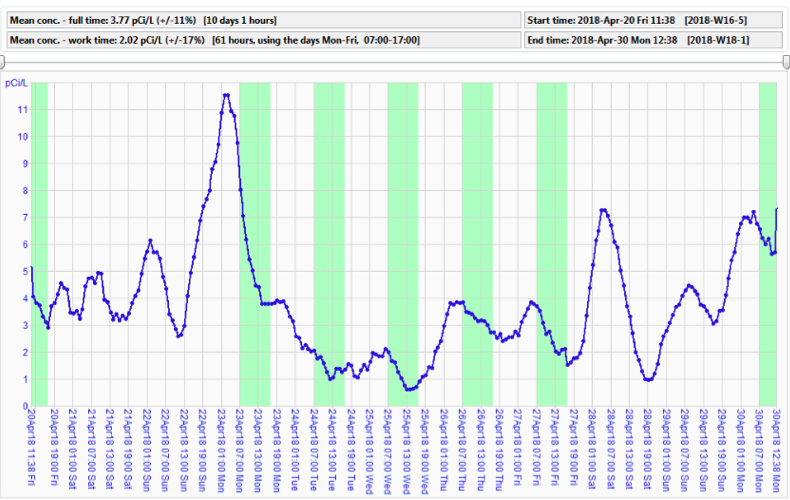“Change is the only constant in life.” The Greek philosopher Heraclitus probably never suspected that his wisdom would apply to home performance. But it’s true! Even a house, an apparently static structure, changes over time, and so do indoor radon levels.
The EPA suggests checking your indoor radon levels every two years. As a home ages, air leakage through the foundation can increases due to the settling of the house. This allows radon gas to seep in more easily. Older homes are notorious for high radon levels for this reason, but new homes can face issues too. The only way to know for sure if radon is a problem in your home is to perform a test.
Many radon tests collect information over a 48 to 96 hour time period. However, this relatively short period of time only captures a very small snap shop and does not necessarily represent the long-term average. Radon levels are variable and long-term testing will give you a better indication of your average exposure. To get an accurate picture of your long-term exposure, we recommend testing for 30 to 90 days.
What influences indoor radon concentration levels?
- The season: Levels tend to be higher in the winter than the summer because we keep our houses more tightly sealed in the colder months. Also, when the ground freezes, it becomes less permeable, creating a path of least resistance through the unfrozen ground below your house.
- Ambient weather conditions: Through our studies, we have seen correlations between radon concentrations, ambient pressure, wind speed and even rain. Although more research is needed to understand these phenomena, we can say with confidence that indoor radon levels have some dependency on the weather.
- How the house is operated: Opening windows and running exhaust fans can change the relative pressure in a house, which changes the rate at which radon enters and leaves the house. Running an exhaust fan for example will put the house under a slight negative pressure, causing a slight suction from wherever cracks exist. If there is significant leakage around the perimeter of the house or through the floor, radon can be sucked up from the crawlspace or basement into the living space.
- Location: Radon concentrations are location dependent. Your neighbor may have a radon mitigation system in place because their test results came back high, but your home may test low. Radon concentration is dependent on the soil make up under your house. Click here to learn more about the geology of radon.
- Time: As mentioned, radon can change from year to year due to the change in leakiness of a house.
Because of these changing variables, a short-term radon test that captures an average concentration over 48 to 96 hours isn’t great at providing a conclusive result. A few of our clients have purchased a digital radon monitor of their own so that they can track radon over time. Here is what one person had to say:
“We purchased [a digital] radon tester last week for the house. It’s been interesting to watch the fluctuations… especially with the rain…. despite the small sample size of just under a week.”
Take a look at the 10-day results we collected from a home in Nashville earlier this year over. The radon levels are highly variable, but on average below 4.0 pCi/L. If a 48-hour test were performed, only part of the story would be represented.

The value you get back from a short-term radon test may not provide all the information you need to make an informed mitigation decision. The EPA recommends the following next steps based on the results of your initial test:
- Less than 4 pCi/L: A follow-up test is usually not necessary. However, the EPA recommends retesting periodically, as levels can change over time.
- 4 to 8 pCi/L: A long-term or short-term follow-up measurement is recommended.
- Greater than 8 pCi/L: A short-term follow-up measurement is recommended in order to evaluate another sample set of data quickly.
If you’re radon levels come back high and you plan to install a mitigation system, be sure to retest at the end of your project. In some cases, additional steps may need to be taken to further reduce levels – such as dedicated ventilation systems.
Take a strategic approach to your radon testing. Perform long-term tests or follow-up tests to get a better idea of the radon trends in your home. Call E3 INNOVATE today to learn more about our Healthy Home Assessments that include radon testing. Contact us today.









